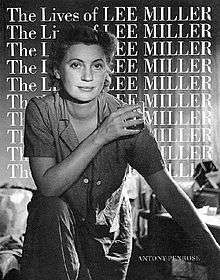Antony Penrose
| Antony Penrose | |
|---|---|
| Born |
Antony William Roland Penrose 9 September 1947 London, England |
| Nationality | British |
| Known for | Photographer |
Antony William Roland Penrose (born 9 September 1947) is a British photographer. The son of Sir Roland Penrose and Lee Miller, Penrose is director of the Lee Miller Archive and Penrose Collection at his parents' former home, Farley Farm House.
Early life and family
Antony Penrose was born on 9 September 1947 in the London Clinic, central London. He is the son of Lee Miller, a model, fine art photographer and noted war correspondent, and Sir Roland Penrose, the surrealist artist, poet and biographer of Pablo Picasso, Joan Miró, Man Ray, and Antoni Tàpies, who co-founded the Institute of Contemporary Arts (ICA) in 1947.
.jpg) Farley Farm House Farley Farm House | |
|
|
His grandfather was Irish painter James Doyle Penrose, and his grandmother was the daughter of the philanthropist Lord Peckover. His uncle was polymath Lionel Penrose, whose children include mathematician Oliver Penrose, polymath Sir Roger Penrose, chess grandmaster Jonathan Penrose, and geneticist Shirley Hodgson.
He first lived at 11 Downshire Hill in Hampstead, but in 1949 his parents bought Farley Farm House, a farmhouse in the village of Chiddingly, East Sussex. His mother suffered from depression during Penrose's childhood, meaning he had a nanny, Patsy Murray, from a young age. Penrose had dysfunctional upbringing, saying of his mother "She was a hopeless mum. She had no natural maternal instincts." He suffered from dyslexia, but nevertheless went on to attend the Royal Agricultural College.[1]
Career

Penrose's mother was his first mentor and main inspiration. The first camera he used was a Kodak with a 120 roll film, which produced 1 1/4 square negatives. At 14, whilst on a family visit, Penrose took some of his first amateur photographs of Picasso. In 1962, he and his mother went on a photography trip to Zimbabwe - but Miller fell ill and so left it to Antony to take the pictures which she could not using her Zeiss Contax. She told him "If you drop the camera I will break your neck".[2]
In the late 1960s Penrose took pictures of famous artists including Picasso, Joan Miró and Man Ray. Penrose's first career move was in agriculture, which he interrupted to spend several years on a round-the-world trip in a Land Rover with his friends Robert Braden and Peter Comrie, cousin Dominic Penrose, and his late wife Suzanna. During this period he took many photos for Farmers Weekly magazine. Later on, Penrose was introduced to film-making, working on films such as Kings Horses and Migrate to Survive. He established Penrose Film Productions Ltd which primarily focuses on documentaries, technical films and drama shorts.
Following the death of his mother, a cache of her work was discovered in the attic of the family home by his late wife Suzanna. It contained some 60,000 negatives, prints and manuscripts, which he and Suzanna made the basis of the Lee Miller Archives. Penrose has since written numerous books, articles and two plays on the subject of his parents and their associates. He is most notable for his 1985 book, The Lives of Lee Miller.[3]
Penrose now gives lectures worldwide on photography, fine art and his parents's work to museums and photographic societies and is accredited by the National Association of Decorative and Fine Arts Societies. He is a director of the Farley Arts Trust,[4] a registered charity,[5] which he founded to promote art education in schools. The trust holds the annual Farleys Yard Arts Award for GCSE and A-level work from several local comprehensive schools.
Publications
Books
- 1988 – The Lives of Lee Miller. Thames & Hudson. ISBN 978-0-03-005833-2.
- 1992 – (editor) Lee Miller's War: Photographer and Correspondent with the Allies in Europe, 1944-45. Condé Nast Books. ISBN 978-0-8212-1870-9 (a book about Miller's photography during World War II)
- 2001 – The Home of the Surrealists: Lee Miller, Roland Penrose, and their Circle at Farley Farm. London: Frances Lincoln. ISBN 978-0-7112-2832-0
- 2001 – Roland Penrose: The Friendly Surrealist. Munich, New York: Prestel. ISBN 978-3-7913-2492-0
- 2010 – The Boy Who Bit Picasso. London: Thames & Hudson. ISBN 978-0-500-23873-8 (a children's book about his experiences of Picasso)
- 2016 – Miró's Magic Animals. London: Thames & Hudson. ISBN 978-0-500-65066-0 (a children's book about his experiences of Miró)
Television
He presented a documentary titled Lee Miller ou la Traversée du Mirroir, directed by Sylvan Roumette for Arte C7, France. It won Best Portrait Film at the Festival de Montreal 1996.[6]
Films
He has 18 credits for promotional, documentary films and short features, four of which achieved cinema distribution. Titles include:[7]
- Kings Horses (1977) - associate producer
- Bright Blue Sky For a Ceiling (1979)[8]
- Strange Behaviour (1980) - director [9]
- The Lives of Lee Miller (1985) - contributor
Theatre
- The Angel and The Fiend: A reading for five voices set to images. First performed in 2003 at the J. Paul Getty Museum.
- Portrait of Space: A reading for six voices set to images. First performed in 2010.
References
- ↑ http://www.theguardian.com/artanddesign/2010/aug/22/picasso-lee-miller-tony-penrose
- ↑ leemiller.co.uk
- ↑ http://www.amazon.co.uk/The-Lives-Miller-Antony-Penrose/dp/0500275092
- ↑ Farley Arts Trust
- ↑ Charity Commission. FARLEY ARTS TRUST, registered charity no. 1104210.
- ↑ Terra-Luna Films
- ↑ http://explore.bfi.org.uk/4ce2ba099f88a
- ↑ IMDb
- ↑ Complete Index To World Film Archived 1 February 2014 at the Wayback Machine.